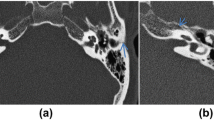Abstract
The use of intraoperative facial nerve (FN) monitoring during surgical decompression of the FN is underscored because surgery is indicated when the FN shows more than 90 % axonal degeneration. The present study proposes including intraoperative monitoring to facilitate decision taking and provide prognostication with more accuracy. This prospective study was conducted on ten patients presenting with complete FN paralysis due to temporal bone fracture. They were referred after variable time intervals for FN exploration and decompression. Intraoperative supramaximal electric stimulation (2–3 mA) of the FN was attempted in all patients both proximal and distal to the site of injury. Postoperative FN function was assessed using House–Brackmann (HB) scale. All patients had follow-up period ranging from 7 to 42 months. Three different patterns of neurophysiological responses were characterized. Responses were recorded proximal and distal to the lesion in five patients (pattern 1); only distal to the lesion in two patients (pattern 2); and neither proximal nor distal to the lesion in three patients (pattern 3). Sporadic, mechanically elicited EMG activity was recorded in eight out of ten patients. Patients with pattern 1 had favorable prognosis with postoperative function ranging between grade I and III. Pattern 3 patients showing no mechanically elicited activity had poor prognosis. Intraoperative monitoring affects decision taking during surgery for traumatic FN paralysis and provides prognostication with sufficient accuracy. The detection of mechanically elicited EMG activity is an additional sign predicting favorable outcome. However, absence of responses did not alter surgeon decision when the nerve was found evidently intact.




Similar content being viewed by others
References
Darrouzet V, Duclos JY, Liguoro D, Truilhe Y, De Bonfils C, Bebear JP (2001) Management of facial paralysis resulting from temporal bone fractures: our experience in 115 cases. Otolaryngol Head Neck Surg 125:77–84
Cocker NJ, Kendal KA, Jenkins HA, Alford BR (1987) Traumatic intratemporal facial nerve injury: management rationale for preservation of function. Otolaryngol Head Neck Surg 97:262–269
Yanagihara N (1982) Transmastoid decompression of the facial nerve in temporal bone fracture. Otolaryngol Head Neck Surg 90:616–621
Yetiser S (2012) Total facial nerve decompression for severe traumatic facial nerve paralysis: a review of 10 cases. Int J Otolaryngol 2012(607359):1–5
Fisch U (1984) Prognostic value of electrical tests in acute facial paralysis. Am J Otol 5:494–498
Gantz BJ, Gmür A, Fisch U (1982) Intraoperative evoked electromyography in Bell’s palsy. Am J Otolaryngol 3(4):273–278
May M (2000) Microanatomy and pathophysiology. In: May M, Schaitkin BM (eds) The facial Nerve, 2nd edn. Thieme, New York, pp 57–66
Gantz BJ (1985) Intraoperative facial nerve monitoring. Am J Otol Nov Suppl:58–61
Bernat I, Grayeli AB, Esquia G, Zhang Z, Kalamarides M, Sterkers O (2010) Intraoperative electromyography and surgical observations as predictive factors of facial nerve outcome in vestibular schwannoma surgery. Otol Neurotol 31(2):306–312
Hato N, Nota J, Hakuba N, Gyo K, Yanagihara N (2011) Facial nerve decompression surgery in patients with temporal bone trauma: analysis of 66 cases. J Trauma 71(6):1789–1792
Chang CY, Cass SP (1999) Management of facial nerve injury due to temporal bone trauma. Am J Otol 20:96–114
Nissen AJ, Sikand A, Curto FS, Welsh JE, Gardi J (1997) Value of intraoperative threshold stimulus in predicting postoperative facial nerve function after acoustic tumor resection. Am J Otol 18(2):249–251
Baba S, Kondo K, Kanaya K, Ushio M, Tojima H, Yamasoba T (2011) Bell’s palsy in children: relationship between electroneurography findings and prognosis in comparison with adults. Otol Neurotol 32(9):1554–1558
Prass R (1992) Intraoperative electromyographic recording. In: Kartush JM, Bouchard KR (eds) Neuromonitoring in otology and head and neck surgery. Raven Press, New York, pp 81–97
JCroxson GR, Moffat DA, Hardy DG, Baguley DM (1989) Role of post-operative electroneuronography in predicting facial nerve recovery after acoustic neuroma removal: a pilot study. Laryngol Otol 103(1):60–62
Gantz BJ, Gmuer AA, Holliday M, Fisch U (1984) Electroneurographic evaluation of the facial nerve. Method and technical problems. Ann Otol Rhinol Laryngol 93:394–398
Rampp S, Rachinger J, Scheller C, Alfieri A, Strauss C, Prell J (2012) How many electromyography channels do we need for facial nerve monitoring? J Clin Neurophysiol 29(3):226–229
LaRouere MJ, Lunday LB (2005) Anatomy and physiology of the facial nerve. In: Jackler RK, Brackmann DE (eds) Neurotology, 2nd edn. Elsevier, Philadelphia, pp 1199–1211
Conflict of interest
The authors declare that they have no conflict of interest.
Author information
Authors and Affiliations
Corresponding author
Rights and permissions
About this article
Cite this article
Ashram, Y.A., Badr-El-Dine, M.M.K. Surgery for traumatic facial nerve paralysis: Does intraoperative monitoring have a role?. Eur Arch Otorhinolaryngol 271, 2365–2374 (2014). https://doi.org/10.1007/s00405-013-2712-9
Received:
Accepted:
Published:
Issue Date:
DOI: https://doi.org/10.1007/s00405-013-2712-9




